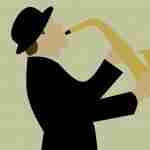Have you ever wondered why great pianists, guitarists, bassists, and drummers often sing along as they improvise? Ever noticed how many of the best horn players also happen to be great singers? Great musicians all over, seem to have developed the ability to sing somewhere along the way, whether they’ve had formal training or not. For all of us, from the musical innovator to the weekend music lover, singing is a natural part of musical development and artistic expression. The voice is in fact our first instrument and one that everyone can play. For serious musicians, though, the voice is a crucial part of our technique and one that can always be improved upon.
One concept that is not often talked about, yet immensely important, is the gap between our ears and what is coming out of our instruments. The fact is that what is easily understood aurally, rarely is translated to our instruments without any work. Internalizing this music takes hours of repeated listening and imitation until it finally appears in our day to day playing.
As improvisers, we rely heavily on our ears to hear the music going on around us, but this is only a small part of developing our ears to their full potential. The real skill comes not in simple identification of intervals and chords, but in the ability to recreate what we hear instantaneously – singing.
Singing a musical idea naturally creates a strong physical connection between our ears and the sounds that we’re hearing. For many of us, the way we learned music in school was from a page directly to our instruments, leaving out our ears and our voices.
Because of this, we need to find a way re-establish a direct connection from our ears to our voice to what comes out of the instrument. The process in which you should learn melodies, chords, anything really, should follow this pattern:
Hear it —> Sing it —> Play it on your instrument
We work all the time on listening (hearing melodies, solos, and chord changes, etc.) and on practicing technique on our instruments, but actually singing what we’re working on too often falls to the wayside. In order to eventually play what you’re hearing, you need to sing anything that you play on your instrument.
Often times, inexperienced players skip theses first two steps and try to play something on their instruments that they can’t hear, let alone have the ability to sing. Virtually shooting in the dark, hoping by some miracle to be able to one day get that line into their playing.
Here are three ways to incorporate singing into your everyday practice routine that will make an immediate difference in your ability to internalize music:
I. You aren’t training your ear unless you’re singing
If singing isn’t already a part of your ear training practice, begin today. Rather than just listening to and mentally identifying that interval, chord type, or progression that you’re working on, try to sing it first; creating a physical connection to the sound as you do.
A quick way to start developing the skill to sing what you hear, is to play a note on the piano and sing that exact note; it’s as simple as that. Focus on the sound of the note in your mind then try to match it precisely with your voice.
This becomes more difficult when you start playing notes that are out of your vocal range, forcing you to sing the note in a different octave; here’s where your ears come into play. After matching one pitch with your voice becomes easy, play an interval and sing both notes or try a chord and sing the bass note.
Sure, it’s easy to identify a perfect fourth or major 7th chord, as most ear training classes teach you, but to be able to sing the notes requires truly internalizing and hearing the intervals; this is the skill that will benefit us when we’re improvising.
Once you can sing what you’re hearing comfortably, the next step is to play on your instrument what you’re singing. As you develop this skill of truly playing what you’re hearing, the benefits will transfer to every part of your playing. By following this process, you are strengthening the bond between your ear all the way to your instrument.
II. Singing is the first step to transcribing quickly
Learning a solo, melody, or chord progression from a record can initially be frustrating and time consuming. One way to significantly improve your success and efficiency at transcribing solos is to sing them. Before you try to learn a solo or melody by ear on your instrument, listen to it repeatedly until you can sing the passage note for note, exactly as it sounds.
Not just singing along approximately with the recording, but singing the line exactly note for note without the aid of the recording. The simple act of singing a line and really hearing what you’re singing greatly simplifies the transcription process. You should be singing everything that you plan on transcribing, from simple lines or melodies to entire solos.
For example, one solo that I have always loved is Chet Baker singing over It Could Happen to You. For years I had sung along with the recording, especially his improvised scat solo. Recently as I was reviewing the tune, I tried to play along with the solo for kicks. To my surprise, I could play the solo without having ever transcribed it or practiced it; solely from the process of ingraining it and singing it.
This is a great solo to try singing because it’s simple, yet very melodic. Listen to the scat solo over and over again until it’s memorized and then try to sing along with the recording:
After you have the solo ingrained into your ear and can sing it confidently without the recording, try to play it on your instrument. You’ll be surprised at how easily it will come to you through the simple act of pre-listening and singing to the things that you’re transcribing.
III. Learn to improvise with your voice…not your mind
An eye-opening experience came for me as I was in one of my trumpet lessons in school. I had been playing the standard I’ll Remember April and my instructor asked me to scat sing a solo instead of improvising one on my horn. Confused, I timidly began to sing a solo over the familiar changes. Surprisingly I had difficulty accurately singing what I usually played on my horn, let alone playing easy diatonic lines.
While I was using tri-tone substitutions and various other harmonic devices on my trumpet, when I sang a solo, I was lucky to get by just with the chord tones. I quickly came to the conclusion that I was only able to sing what I was truly hearing and couldn’t rely on harmonic knowledge or licks worked out on my horn…and what I could actually hear and sing wasn’t very much.
Even though we may not realize it, our instruments are a crutch that we rely on as we improvise. We hear a chord or melodic fragment and once we find the key on our instruments, we use the scales, chords, and licks we’ve worked out in that key as the basis for improvisation. In reality, all that knowledge and technique that we have acquired over the years is getting in the way of our ears, or lines that we would naturally hear. Instead of playing the melodies we’re hearing, we use our brains to “improvise,” fitting together lines and patterns that we have memorized once we’ve figured out the key.
When you are forced to sing instead of play an improvised solo, you truly have to play what you hear. Pushing down a key or valve will not automatically guarantee a correct note in this case. Scatting a solo is a sure way to tell if your ears are up to the level of the rest of your instrumental technique. By incorporating the simple act of singing into your ear training practice as well as your transcription process, you’ll see a noticeable difference in the way you are hearing things and how you play them on your instrument.
Your voice is always with you, so remember to use it in everything that you do musically, it can only help you!










